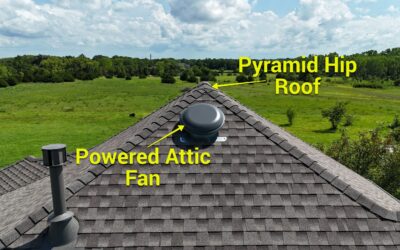What Is Ridge Vent and What Does It Do?
Ridge vent is a continuous ventilation system installed along the top ridge of a sloped roof, allowing warm, humid air to exhaust from the attic. They are the modern standard for exhaust ventilation because they exhaust air across the length of the roof and minimize the chance for water infiltration, promoting balanced airflow. See Why Is Proper Attic Ventilation So Important to learn more about the importance of balanced airflow. Ridge vents are either discreet and difficult to notice from the ground, or they can be installed with high-profile ridge caps to frame the house.
To work correctly, a ridge vent needs enough ridge length to suffice for the attic’s exhaust demands. That’s why some roof designs, like pyramid hips or other complex hip designs, can’t use them. When there’s no continuous ridge to vent through, roofs rely on other options like box vents, turbines, powered vents or off-ridge vents for exhaust. These perform the same function below the roof’s ridge.
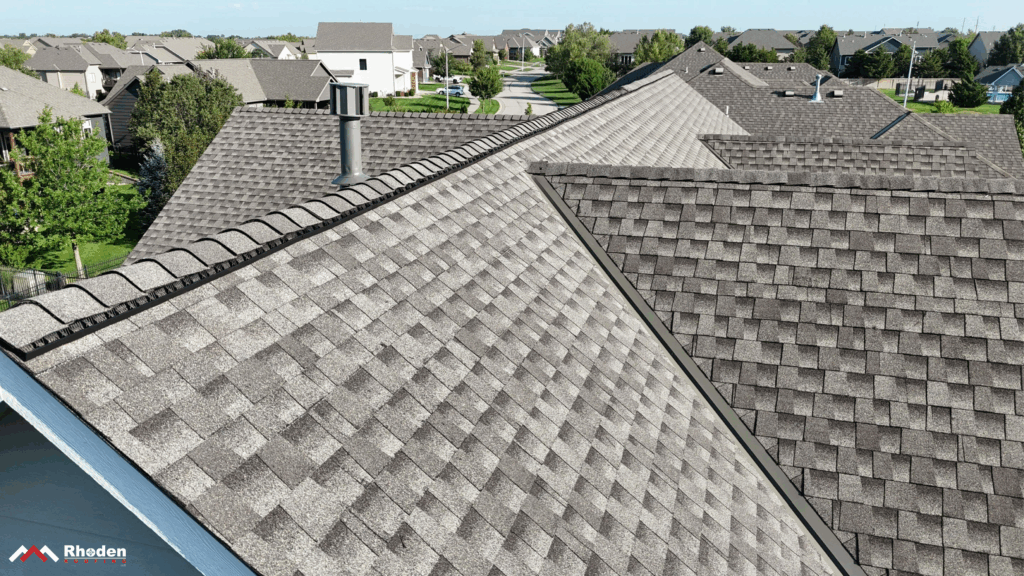
Expected Service Life of Ridge Vent
Ridge vents don’t wear out – they just wait to be damaged, like other shingle-over components. Because they are installed beneath the ridge caps, they’re shielded from UV radiation, rain, and most physical wear. The vent and its baffles are made with UV-resistant polymers, exposed to water only during strong, wind-driven rain. In most cases, ridge vents will last as long as the roof itself. Failure typically results from improper installation or acute damage, not time.
0-5 Years: New Installation – Evaluating for Correct Installation
A well-installed ridge vent will last for the lifetime of the roof system it’s installed on. Improper installation is one of the few ways a ridge vent can fail.
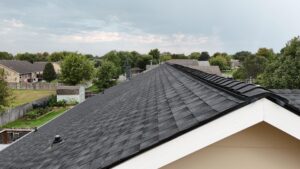
-
- Incorrect end cuts: Ridge vent is often supplied in 4’ pieces. Where the ridge vent terminates at the end of the ridge, usually at a gable end, the vent often needs to be cut so it doesn’t extend off the roof. The uncut side has polymer baffles that keep wind-driven rain out. If the cut side without a baffle is facing the rakes, water has a clear path to enter the attic from the ridge. The ends of ridge vent have polymer baffles that 1) allow for a small amount of exhaust, and 2) prevent wind-driven rain from entering the attic.
- Nails too short: Ridge vents require at least 1 3/4-inch nails to properly secure to the roof decking. They’re 7/8” thick, so longer nails are typically required to secure it. If standard 1 1/4-inch roofing nails are used, the ridge vent is liable to blow off, taking the ridge caps installed over it with it.
- Vent baffles obstructed by shingles: Standard field shingles and ridge caps have different exposures. If uncut field shingles are used as ridge caps, they can obstruct the vent opening, effectively reducing the available NFA (net free area).
- Inadequate slot length: A ridge vent without a continuous slot is just decoration. We’ve seen roofs where the vent runs the length of the ridge but the actual cut area, the slot that lets air escape, only covers a portion of the length. Without a slot, there’s no exhaust, which is the purpose of ridge vent. This can be identified with a daylight test: on a bright day you should see light entering the attic space on either side of the ridge. If the light is missing or decking continues to the peak of the ridge, the slot is incomplete and the vent may not exhaust adequately.
- Slot cut too wide: A 7/8” cut on both sides of the ridge’s peak is used for ridges without a ridge board and 1 5/8” cuts are used on both sides of ridges with a ridge board. A ridge board is the framing member that runs along the ridge of the roof, joining the rafters. A wider cut is used to allow airflow on either side of the board. However, double-cutting, or using a 3 1/4” or greater cut with standard ridge vent, has the potential to short-circuit the ventilation system. See our article How to Improve Attic Ventilation to learn more.
- Mixed exhaust methods: Air should have a single exhaust method from the attic at the apex of the roof. Mixing exhaust methods (e.g., ridge vent paired with box vents for a single attic space) risks short-circuiting the ventilation system, no different from drinking through a straw with a hole in the middle: some air will make it to the end, but much of it will escape through the hole.
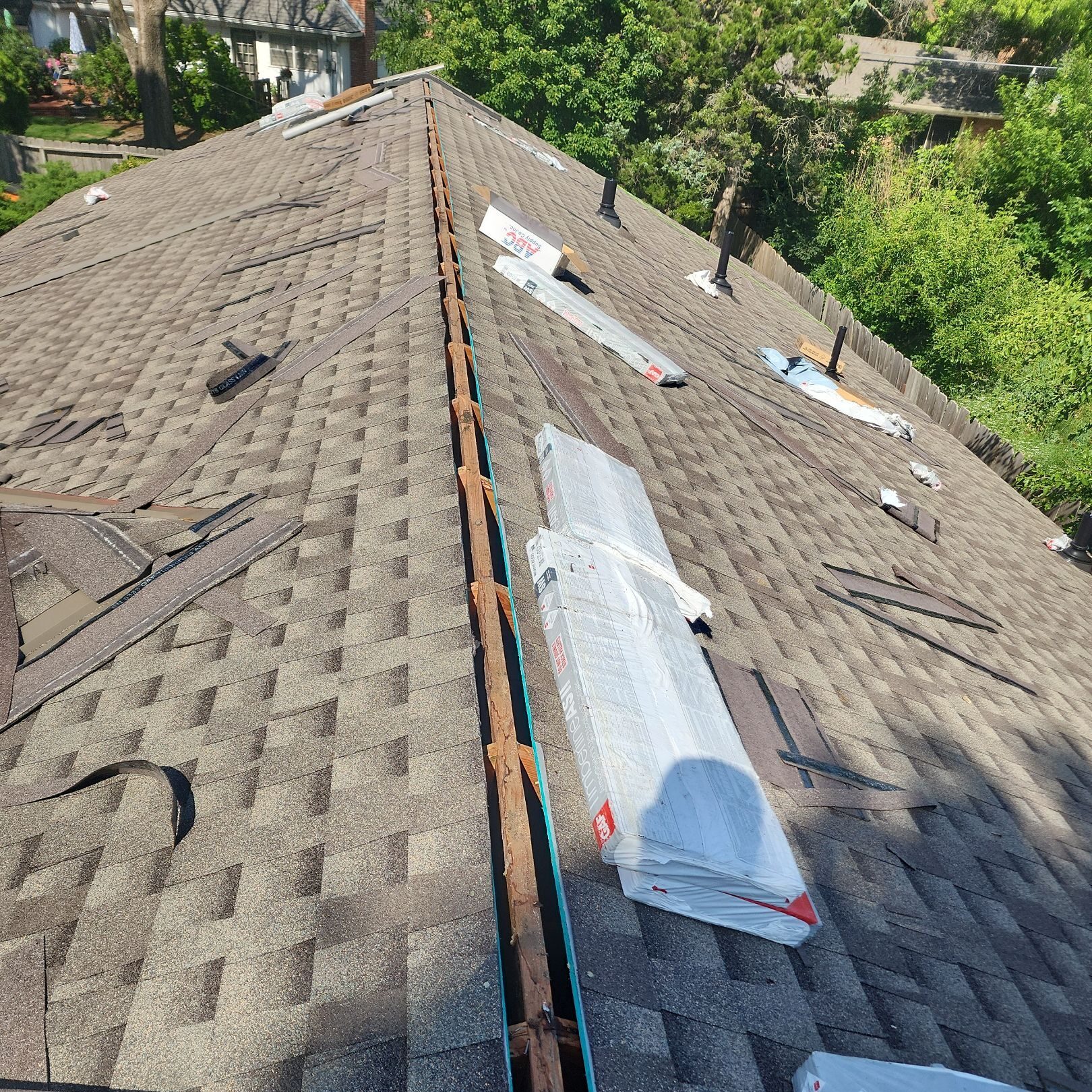
An open slot for a ridge vent on an asphalt shingle roof with an exposed ridge board at the center of the ridge. The slot is cut to allow air to flow out from either side of the ridge board. This house has one uninterrupted attic space, allowing ridge vent to be installed from one gable end to the other.
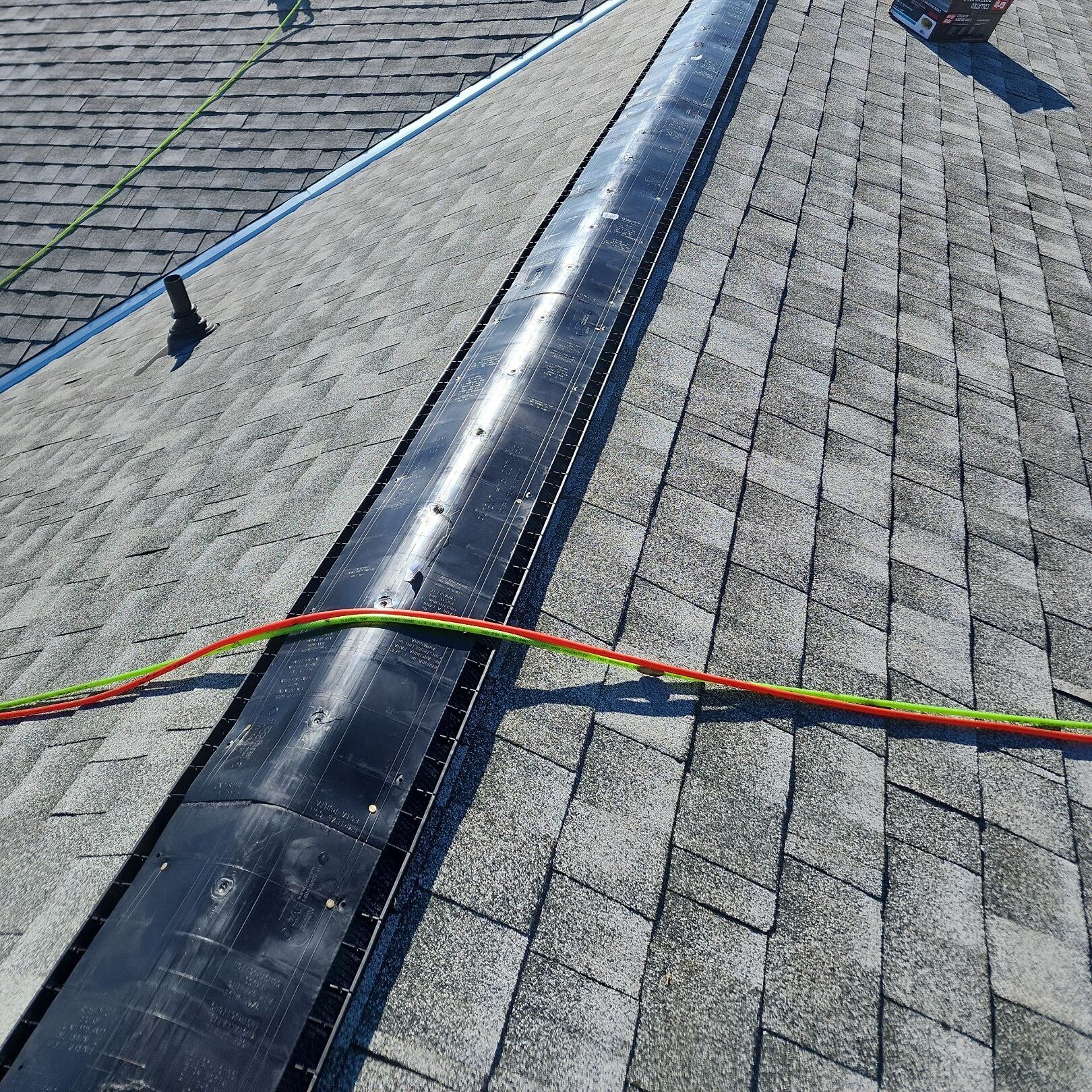
Gaf’s Cobra ridge vent installed during a re-roof. All vent sections are installed before ridge caps. The open slot that permits air to exhaust is inside from the baffles, or further up slope. This reduces the likelihood that wind-driven rain can eclipse the baffles once ridge caps are installed.
10-40 Years: Normal Weathering – What to Monitor
Once properly installed, ridge vent generally ages without much visible change. It’s shingled over and shielded from sunlight and water, so it doesn’t usually crack or degrade like exposed metals or sealant can. Monitoring ridge vents at this stage is less about cosmetic changes and more about keeping the vent pathway clear.
-
- Debris accumulation in baffles: Leaves, dust, or nesting material can accumulate over time, obstructing airflow and interrupting the balanced ventilation system. This is often noticed from the attic, where light is obscured by any debris caught in the baffles. The baffles can be cleared from the attic or the ridge of the roof.
- Fastener loosening: After decades of thermal expansion and contraction, the ridge vent’s fasteners may begin to back out. Unless they have pulled out completely, they can simply be hammered down.
Maintenance: Clean or re-fasten backed out nails. The vent and its baffles should be cleaned periodically. The vent itself will not be damaged by obstructions, but its job is to allow air to exhaust from the attic, and blockages prevent this. If fasteners begin to lift, they need to be re-driven. Bent fasteners that damage a 4′ vent section will require more extensive repairs.
20-40 Years: Failure & Replacement – Knowing When It’s Time
The functional life cycle of a roof component is determined by its ability to keep water out. The transition from normal aging to concerning wear isn’t always clear. Ridge vents don’t typically deteriorate like exposed metals or rubber, but they can still fail if physical damage or installation errors compromise the vent pathway. On almost any roof, ventilation components represent a potential failure point because a blocked or damaged vent can trap heat and moisture in the attic, leading to wider roof system issues. We created an inspection checklist to standardize our recommendations, ensuring that replacement is only suggested when it’s necessary. Similar to how an insurance adjuster defines “totaled” on a car, we only recommend component replacement when the cost to replace a component or roof is less than the potential cost of damages over the next 12 months.
Based on our experience identifying and fixing ventilation-related leaks and failures on over 13,000 homes and buildings, here are our criteria for when we recommend replacement of ridge vents:
- Localized or widespread physical damage to vent sections: Acute impacts from foot traffic, large hailstones, or tree branches can crack the vent and cause baffle sections to break. Once the vent is fractured, its ability to effectively exhaust air could be compromised and an avenue for water infiltration is created.
- Water intrusion – If any amount of moisture has seeped through the slot or surrounding decking, the intake vent will need replaced. Signs of water inside will be visible as discoloration to surrounding wood or insulation, grime lines, mold, or spots on drywall below.
- Compromised seal with the roof deck – Thermal cycling may cause the once-flush vent to pull away from the roof deck. Similar to buckled roof decking, this presents as a visible gap at the vent’s edges or unnaturally raised shingles over the vent. These gaps can create a direct pathway for water infiltration.
Frequently Asked Questions (FAQ)
Are ridge vents better than box vents?
Ridge vents generally provide superior exhaust ventilation and reduce the chance of stagnant spots without passive ventilation. This makes them our preferred form of exhaust ventilation. Box vents can perform well in small, enclosed attic spaces or as budget options, but they don’t ventilate across the entire ridge. In short, ridge vents ventilate better; box vents are a decent alternative when the roof’s geometry or budget make continuous ridge venting untenable.
See our article comparing ridge vents to box vents for a detailed breakdown of which is better for your roof.
Are ridge vents expensive?
For new construction, ridge vents are comparable in price to box vents. On reroofing projects, ridge vents are usually more expensive. The labor required to cut a continuous slot in the ridge, install the vent, and install ridge caps is more involved than a traditional box vent installation.
Box vents are penetrations with sealant applied over otherwise exposed fasteners. This requires regular maintenance to avoid leaks. Ridge vents, by contrast, are integrated into the roof system, providing consistent protection with less maintenance.
Ultimately, while ridge vents are likely to require a higher initial investment, reduced maintenance can save money long-term.
This article is part of our ‘Roof Component Inspection & Service Life’ Series. Learn more about:
Flashing
Roof Vents


